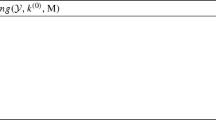Abstract
Given sales forecasts for a set of items along with the standard deviation associated with each forecast, we propose a new method of combining forecasts using the concepts of clustering. Clusters of items are identified based on the similarity in their sales forecasts and then a common forecast is computed for each cluster of items. On a real dataset from a national retail chain we have found that the proposed method of combining forecasts produces significantly better sales forecasts than either the individual forecasts (forecasts without combining) or an alternate method of using a single combined forecast for all items in a product line sold by this retailer.
Similar content being viewed by others
References
Bates, J. M., & Granger, C. W. J. (1969). The combination of forecasts. Operational Research Quarterly, 20, 451–468.
Brucker, P. (1977). On the complexity of clustering problems. In R. Hehn, B. Korte, & W. Oettli (Eds.), Optimization and operations research (pp. 45–54). Berlin: Springer.
Bunn, D. W., & Vassilopoulos, A. I. (1999). Comparison of seasonal estimation methods in multi-item short-term forecasting. International Journal of Forecasting, 15(4), 431–443.
Clemen, R. (1989). Combining forecasts: A review and annotated bibliography. International Journal of Forecasting, 5(4), 559–583.
Duncan, G., Gorr, W. L., & Szczypula, J. (2001). Forecasting analogous time series. In J. S. Armstrong (Ed.), Principles of forecasting: A handbook for researchers and practitioners (pp. 195–213). Dordrecht: Kluwer.
Fay, R. E., & Herriot, R. A. (1979). Estimates of income for small places: An application of James-Stein procedures to census data. Journal of the American Statistical Association, 74, 269–277.
Fisher, W. D. (1958). On grouping for maximum homogeneity. Journal of the American Statistical Association, 53, 789–798.
Fomby, T. B., & Samanta, S. K. (1991). Application of Stein rules to combination forecasting. Journal of Business and Economic Statistics, 9(4), 391–407.
Kumar, M., & Patel, N. R. (2007). Clustering data with measurement errors. Computational Statistics & Data Analysis, 51(12), 6084–6101.
Kumar, M., Patel, N. R., & Woo, J. (2002). Clustering seasonality patterns in the presence of errors. In: Proceedings of the 8th ACM international conference on knowledge discovery and data mining (pp. 557–563), Edmonton, Canada.
Maharaj, E. A., & Inder, B. A. (1999). Forecasting time series from clusters (Monash Econometrics and Business Statistics Working Papers). Monash University, Department of Econometrics and Business Statistics, 9/99.
Menezes, L. M., Bunn, D. W., & Taylor, J. W. (2000). Review of guidelines for the use of combined forecasts. European Journal of Operational Research, 120(1), 190–204.
Mentzer, J. T., & Cox, J. E. (1984). Familiarity, application, and performance of sales forecasting techniques. Journal of Forecasting, 3(1), 27–36.
Milligan, G. W., & Cooper, M. C. (1985). An examination of procedures for determining the number of clusters in a data set. Psychometrika, 50(2), 159–179.
Mitchell, R. J. (2003). Forecasting electricity demand using clustering. Applied Informatics, 225–230.
Stein, C. (1956). Inadmissibility of the usual estimator for the mean of a multivariate distribution. In Proceedings of the 3rd Berkeley symposium on mathematical statistics and probability (Vol. 1, pp. 197–206). Berkeley: University of California Press.
Terregrossa, S. J. (2005). On the efficacy of constraints on the linear combination forecast model. Applied Economics Letters, 12(1), 19–28.
Ward, J. H. (1963). Hierarchical grouping to optimize an objective function. Journal of the American Statistical Association, 58, 236–244.
Author information
Authors and Affiliations
Corresponding author
Additional information
The authors would like to thank ProfitLogic Inc. for providing data.
Rights and permissions
About this article
Cite this article
Kumar, M., Patel, N.R. Using clustering to improve sales forecasts in retail merchandising. Ann Oper Res 174, 33–46 (2010). https://doi.org/10.1007/s10479-008-0417-z
Published:
Issue Date:
DOI: https://doi.org/10.1007/s10479-008-0417-z




